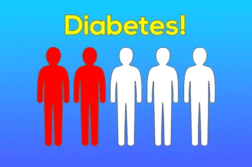BALTIMORE, Md. (Ivanhoe Newswire) — You might not know this, but up until a generation or two ago, women with type 1 diabetes were often advised to avoid getting pregnant and having children because of the health risks – both to mom and baby. Medical advances have now made it safe for these young women to have families, with careful planning.
For 25-year-old Elon Barnes, little Robert is the center of her world. “He is just a happy little energetic baby.” Barnes says.
But when Barnes first learned she was pregnant, she knew she would have to work hard for his health and her own. Barnes was diagnosed with type 1 diabetes ten years ago.
“I had actually just learned about diabetes in my high school biology class.” Explains Barnes
With type 1 diabetes, the pancreas produces little or no insulin and patients can have blurry vision, frequent urination and extreme thirst.
Barnes says, “There’s not enough water in the world right now to quench this thirst.”
Diabetes specialist doctor Rachael Oxman says it’s important for women to begin planning before becoming pregnant. “The first trimester is a really tricky period in the pregnancy, that’s when babies forming all of their organs and we want baby to have a healthy spine and healthy heart and diabetes control directly contributes to these things.”
Doctor Oxman says patients should have an A1C, or average blood sugar level, of 6 or 6.5 percent or lower during the first trimester. She says women should not be afraid to take their insulin. “It doesn’t cross the placenta. It doesn’t get to baby.”
Barnes used a continuous glucose monitor to keep a watchful eye on her blood sugar.
Barnes states, “I had to be a very well-behaved diabetic to say the least.”
Hard work, that paid off with a normal delivery and a perfect baby boy.
Doctor Oxman says it’s also critical for new moms with type 1 diabetes to continue to monitor their blood sugars immediately after delivery and in the weeks after that as their bodies recover. It’s also important to select a pediatrician who is familiar with the needs of babies born to moms with type 1. A baby’s pancreas after delivery needs a few days to self-regulate, so their blood sugars need careful monitoring. Elon Barnes says Robert had low blood sugar right after delivery but his system did regulate and has no evidence of diabetes.
Contributors to this news report include: Cyndy McGrath, Producer; Roque Correa, Editor, and Kirk Manson, Videographer
Sources:
PREGNANCY AND TYPE 1 DIABETES
REPORT #3019
BACKGROUND: Around 1.45 million Americans suffer from and live with Type 1 diabetes. That number is expected to climb to 2.1 million by the year 2040. Having Type 1 diabetes can be very difficult and frustrating to live with. It affects every aspect of life from diet to physical activity, to personal relationships. It can be a life-threatening disease and there is currently no existing cure. Warning signs of Type 1 Diabetes are drowsiness, extreme thirst, increase in appetite, sugar in the urine, and frequent urination. If you suffer from Type 1 Diabetes and become pregnant it is important that you immediately consult your medical team to manage your blood sugar and mend off any future complications. During a pregnancy with existing Type 1 Diabetes, your doctor will frequently adjust your treatment and management schedules. You will want to find an endocrinologist, an obstetrician, and a diabetes educator. This will give you a doctor who treats hormonal conditions, a doctor who specializes in pregnancy, and a specialist to regularly consult on your diabetic condition.
https://www.cdc.gov/diabetes/library/features/type-1-and-pregnancy.html
THE STUDY: Recent studies and medical findings are creating a safe space for women with type 1 diabetes to start families. This, however, requires a lot of planning and precautions. It is important for women to hold a blood sugar level of six percent or lower during the first trimester. Taking insulin is also extremely important. These both protect the baby’s spine and keep the heart healthy throughout the duration of the pregnancy. Glucose monitors can keep track of blood sugar and are beneficial for pregnant woman with type 1 diabetes to use. Managing the stress that comes with Type 1 Diabetes and pregnancy can also greatly help a women’s health in pregnancy as stress can negatively impact a baby. Women with type 1 diabetes starting families should also monitor their blood sugar levels weeks after birth to ensure their bodies are recovering safely and properly.
(Source: https://beyondtype1.org/labor-delivery-type-1-diabetes/
NEW REGULATIONS: Women with Type 1 Diabetes are at higher risk for developing pre-eclampsia. It is vital that they monitor their blood sugar during pregnancy for this reason. To help improve the outcome of pregnancy, preconception care should be well planned. Glycemic control, Body Mass Index, and Nutrition should be maintained up until birth and for weeks after to allow the body to return to its resting state. Around half of existing pregnancies that have type 1 diabetes are unplanned. It is crucial that planning occurs through the duration of the pregnancy to ensure the baby and mother’s safety. Tracking thyroid is also beneficial as autoimmune thyroid is prevalent in women with type 1 diabetes.
(Source: https://www.ncbi.nlm.nih.gov/pmc/articles/PMC4919374/
* For More Information, Contact: Dan Collins
Free weekly e-mail on Medical Breakthroughs from Ivanhoe. To sign up: http://www.ivanhoe.com/ftk



